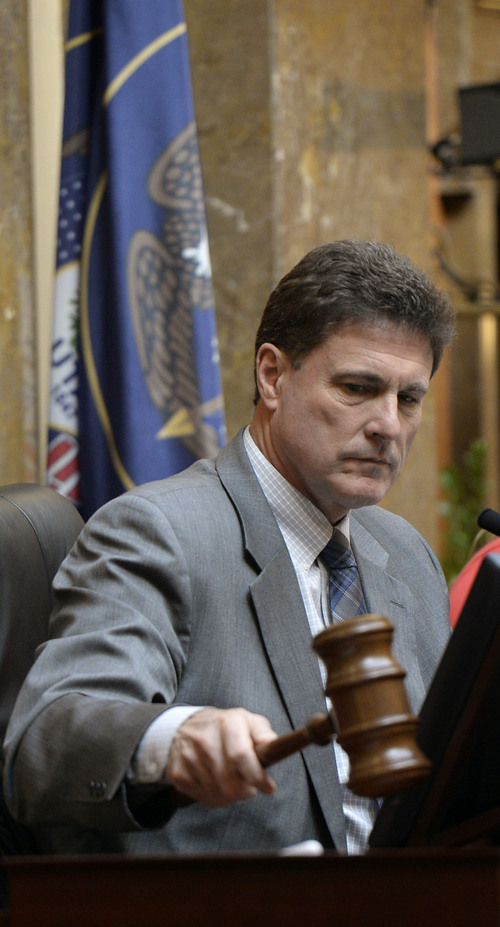This is an archived article that was published on sltrib.com in 2014, and information in the article may be outdated. It is provided only for personal research purposes and may not be reprinted.
Transportation officials were a bit too fast and loose — and wrong — with their facts this week as they told legislators how safe Utah's new 80-mph-speed zones have proven.
Tuesday, the state's top highway official told lawmakers considering a massive expansion of the speed zones that no fatal accidents had occurred in them. It turns out that is not true.
The Tribune found records indicating there actually were at least 16 deaths in the past three years in those zones, although highway officials now say just two were speed related — and the driver in one was doing only 75, or below the limit, but was cited for speeding "too fast for conditions."
"We haven't had any fatal crashes in these [80-mph] areas," Utah Department of Transportation Executive Director Carlos Braceras told the House Transportation Committee on Tuesday before it voted 7-1 to endorse HB80. The bill would allow 80-mph zones anywhere on freeways that UDOT determines would be safe.
The bill's sponsor, Rep. Jim Dunnigan, R-Taylorsville, also said, "We've had no fatalities." Similar assertions were made last year when the Legislature passed another bill that added 289 miles more of 80-mph zones.
But The Tribune found data from the Utah Highway Safety Office showing four fatal crashes each in 2011 and 2012 in 80 mph zones . (The data did not indicate whether there were multiple deaths in any of those eight fatal accidents.) In 2013, seven fatal crashes occurred in the zones resulting in eight deaths, said Gary Mower, research analyst with the safety office. That office is part of the Department of Public Safety, not UDOT.
Dunnigan said he did not independently confirm the fatality data, but was merely quoting information from UDOT to the committee. Robert Hull, UDOT director of traffic and safety, said his agency should have said that no "speed-related" fatalities occurred in early before-and-after studies of 80 mph speed zones from 2009-11. "Those words were left off the talking points." He added, "There were fatal accidents, but speed was not the cause."
A speed-related death did occur in the zones in 2012. But Hull said the ticket issued was for "traveling too fast for conditions," and showed the driver was traveling 75 mph. "He wasn't even going 80 mph," so Hull said the crash likely wasn't related to the higher speed limit.
Another speed-related fatality occurred last year. Hull said a car doing only 50 mph was rear-ended by a car "exceeding the speed limit," but the investigating officer did not say exactly how fast it was traveling.
Dunnigan said he doesn't feel those disclosures hurt his bill because UDOT data shows overall prevailing speeds have not increased much in the zones. They rose by 1-2 mph in some test zones, and actually dropped by 1 mph in others, he said.
"The prevailing speed essentially hasn't changed," he said. "Changes in the speed limit did not change people's behavior. They kept traveling the same speed that they were before."
Rolayne Fairclough, spokeswoman for AAA travel services company, was the only person to testify against the bill in committee. She said the accident disclosures could make a difference.
"It was a compelling argument that no fatalities had occurred in these zones. With the new information, I hope it will bring more consideration that the zones pose a safety threat. We don't get to drive fast without consequences," she said.
Rep. Janice Fisher, D-West Valley City, cast the only vote against the bill in committee. She said the new information does make a difference.
"I think it helps to show that when you are going 80 mph," Fisher said, "you are going to be seriously injured or killed if you get in an accident."
In the 2011 and 2012 reports containing data about the fatal crashes in the 80-mph zones, the highway safety office wrote: "Studies show that a 5 percent increase in average speed leads to a 10 percent increase in injury crashes and a 20 percent increase in fatal crashes."
Daniel Fuhr, superintendent of the Utah Highway Patrol, also testified on Tuesday that "the faster a car travels, the mores severe injury you are going to have" in an accident.
"I don't want to talk to statistics because [UDOT] Director Braceras has the most accurate statistics on crashes, injuries and fatalities [in 80 mph zones]," Fuhr added. "So I would hate to contradict his testimony. But the faster we go, the more susceptible we are to injuries and more serious crashes."



